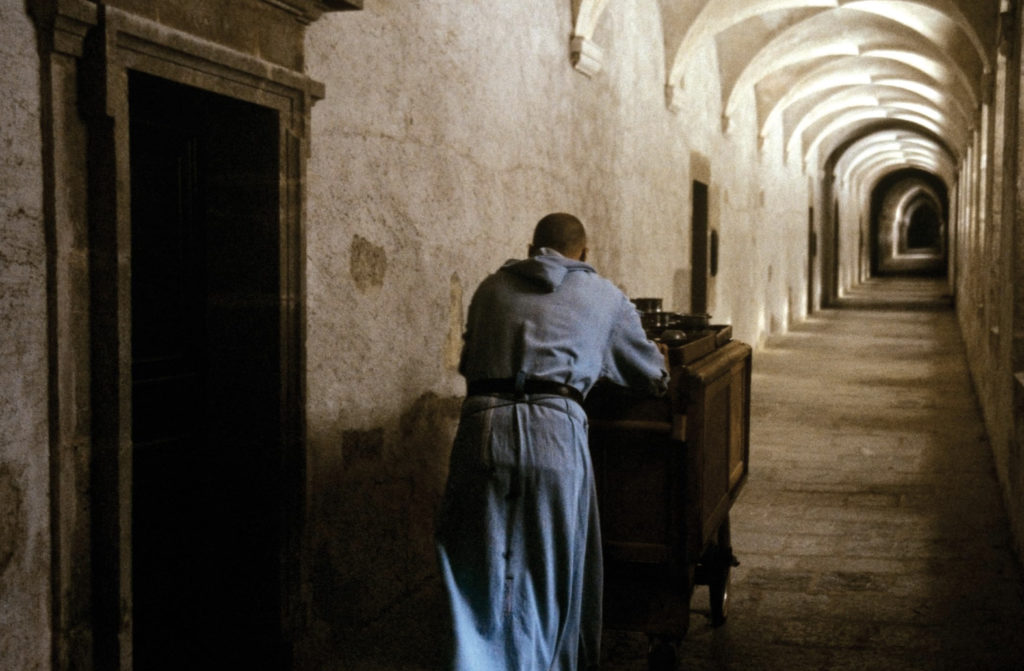“The Father spoke from all eternity just one Word. And he spoke it in an eternal silence. And it is in silence that we hear him.”
— St. John of the Cross
“Into Great Silence” is an award-winning 2005 art-house documentary about the Grande Chartreuse, the famed Carthusian monastery high in the French Alps.
German director Philip Gröning approached the monks in 1984, asking for their permission. “We’ll get back to you,” they said. Sixteen years later, they finally gave the green light.
Gröning filmed alone for six months, following along as best he could with the monks’ rigorous schedule. Their lives are ordered to the Divine Office. The main prayer begins at midnight and continues for two to three hours. Mass is at 8 a.m. Most of the rest of their time is spent alone praying in their cells.
Their meals are delivered from a wheeled wooden trolley, pushed by a brother through the kind of metal slots you see in prison movies.
They never sleep for more than three hours at a time. They don’t talk.
The documentary has no soundtrack, no music. Philosophy professor Zena Hitz observes: “The film, like the place, is silent. Our feelings are invited, rather than provoked or managed. Yet it hides a truth about monastic silence from its viewers: Our thoughts make a racket.”
The sounds are of sandal-shod feet on stairs, a knife on a cutting board, twittering birds. The turn of a page of Scripture. Water being poured from a dishpan. The scrubbing of a spoon. A monk softly beckoning the resident cats to their meal.
The snip of heavy hand-forged shears on the thick creamy fabric that will be made into sumptuously-draped robes and cowls.
How tenderly the tailor takes the measurements of his brother!
Doors, stalls, paneling, shutters, cupboards, and floors are all of a rich honeyed wood. In the kitchen, food is prepared on thick marble counters. Walls are of ancient stone; roofs of glazed tile.
The bell calls the monks to prayer. They process down a long arched colonnade that looks like a keyhole, or the entrance to the womb of creation. In the chapel’s shadowed candlelight, they chant.
In his blue workaday robe, one monk makes his way through the winter snow, slipping and groaning. He laboriously shovels out a raised vegetable bed, then returns to a wooden shed to sort through packets of carrot and cauliflower seed.
Another monk walks split wood up a flight of stairs in a special carrier.
A note is passed, hand-written in black fountain pen: “Chère Frère — asking for extra bed coverlets.”
Light falls upon a page of the breviary. A finger dips into a font of holy water. Curtains billow. The camera lingers on a two-handled pottery cup, complete in itself, long-used, well-loved … dare we think, like us?
How can a cup make you want to cry?
Spring comes. Deep gold crocuses push through the earth.
A Cézanne still life: a wooden bowl of oranges and pears, heartbreaking in their simple beauty, caressed by the afternoon sun.
The film returns again and again to two passages from Scripture: “He who does not give up everything cannot be My disciple” (Luke 14:33); and “You seduced me, O Lord, and I let myself be seduced” (Jeremiah 20:7). Finding a balance between the two, observed Gröning in an interview with Steven D. Greydanus of “Decent Films,” is “the field of tension in which monks live.”
“On the one hand, you do have to be very hard on yourself, and strict, and get rid of a lot of things. On the other hand, if you only follow this path of discipline, then you’re just a masochistic person and you’re not going to be a good monk either. So you have to have this other level of letting yourself go, letting yourself be seduced, and the balance between the two of them is sort of the eternal struggle. … And this is very similar for us.”
On Sundays and solemnities the monks meet in the refectory for a meal. After Nones, the mid-afternoon prayer, a period of conversation is allowed. “Rejoice, be of one mind, be at peace,” is their guiding concept.
In one such conversation, they discuss whether to discontinue the canonical practice of washing their hands before the refectory and drying their hands on a linen curtain. They note what other monasteries do: “At Sélignac they haven’t washed their hands before refectory for 20 years.”
Another monk opines: “When we abolish the signs, we lose our orientation. Instead, we should search for their meaning.”
We’re plunged momentarily into the outside world: one monk is leaving at noon sharp the next day for Seoul.
One of the final shots is of the monks, in a rare hour of recreation, frolicking in the snow and somersaulting down a slippery hill in their robes.
At the conclusion of filming, the monks asked Gröning what he’d learned from his time at the Grande Chartreuse.
“I realized that what I had actually learned,” he responded, “was that it is possible to live very much without fear, because this is what they do. They live without fear.”

